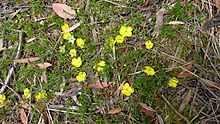Hibbertia procumbens
| Spreading guinea flower | |
|---|---|

| |
| Hibbertia procumbens near Lake St. Clair | |
| Scientific classification | |
| Kingdom: | Plantae |
| Clade: | Tracheophytes |
| Clade: | Angiosperms |
| Clade: | Eudicots |
| Order: | Dilleniales |
| Family: | Dilleniaceae |
| Genus: | Hibbertia |
| Species: | H. procumbens
|
| Binomial name | |
| Hibbertia procumbens | |
| Synonyms[1] | |
| |

Hibbertia procumbens, commonly known as spreading guinea flower,[2] is a species of flowering plant in the family Dilleniaceae and is endemic to south-eastern Australia. It is a prostrate, often mat-forming shrub with more or less glabrous stems, linear to narrow lance-shaped leaves with the narrower end towards the base, and yellow flowers with eighteen to twenty-five stamens arranged in groups around usually four glabrous carpels.
Description
[edit]Hibbertia obtusifolia is a prostrate, often mat-forming shrub with more or less glabrous branches up to 30 cm (12 in) long. The leaves are linear to lance-shaped with the narrower end towards the base, 3–19 mm (0.12–0.75 in) long and 0.4–2.1 mm (0.016–0.083 in) wide with a rounded end and usually a groove along the upper surface. The flowers are arranged on the ends of branches and are sessile, surrounded by a cluster of up to six leaves. The sepals are 5.3–10.5 mm (0.21–0.41 in) long and of unequal lengths. The petals are bright yellow, egg-shaped with the narrower end towards the base, and 4.0–15 mm (0.16–0.59 in) long. There are eighteen to twenty-five stamens arranged in groups around usually four glabrous carpels. Flowering occurs from October to December.[2][3][4][5]
Taxonomy
[edit]Spreading guinea flower was first formally described in 1806 by Jacques Labillardière who gave it the name Dillenia procumbens in Novae Hollandiae Plantarum Specimen.[6][7] In 1817, Augustin Pyramus de Candolle changed the name to Hibbertia procumbens in Regni Vegetabilis Systema Naturale.[8][9] The specific epithet (procumbens) means "low-lying".
Distribution and habitat
[edit]Spreading guinea flower occurs in New South Wales, Victoria and Tasmania, growing in sandy soil, usually in heath. It is widespread and common in Tasmania, found in near-coastal areas of southern Victoria, but rare in New South Wales where it only occurs on the Central Coast near Somersby, Kulnura and Mangrove Mountain.[2][3][5][10]
Conservation status
[edit]Hibbertia procumbens is listed as "endangered" under the New South Wales Government Biodiversity Conservation Act 2016.[5]
References
[edit]- ^ a b "Hibbertia procumbens". Australian Plant Census. Retrieved 28 August 2021.
- ^ a b c "Hibbertia procumbens". Royal Botanic Garden Sydney. Retrieved 28 August 2021.
- ^ a b Toelken, Hellmut R. "Hibbertia procumbens". Royal Btanic Gardens Victoria. Retrieved 28 August 2021.
- ^ Wood, Betty. "Hibbertia procumbens". Lucid Keys. Retrieved 28 August 2021.
- ^ a b c "Spreading Guinea Flower - profile". New South Wales Government, Office of Environment and Heritage. Retrieved 28 August 2021.
- ^ "Dillenia procumbens". APNI. Retrieved 28 August 2021.
- ^ Labillardière, Jacques (1806). Novae Hollandiae Plantarum Specimen. Vol. 2. Paris. pp. 16–17. Retrieved 28 August 2021.
- ^ "Hibbertia procumbens". APNI. Retrieved 28 August 2021.
- ^ de Candolle, Augustin P. (1817). Regni Vegetabilis Systema Naturale. Paris. p. 427. Retrieved 28 August 2021.
- ^ Jordan, Greg. "Hibbertia procumbens". University of Tasmania. Retrieved 28 August 2021.
